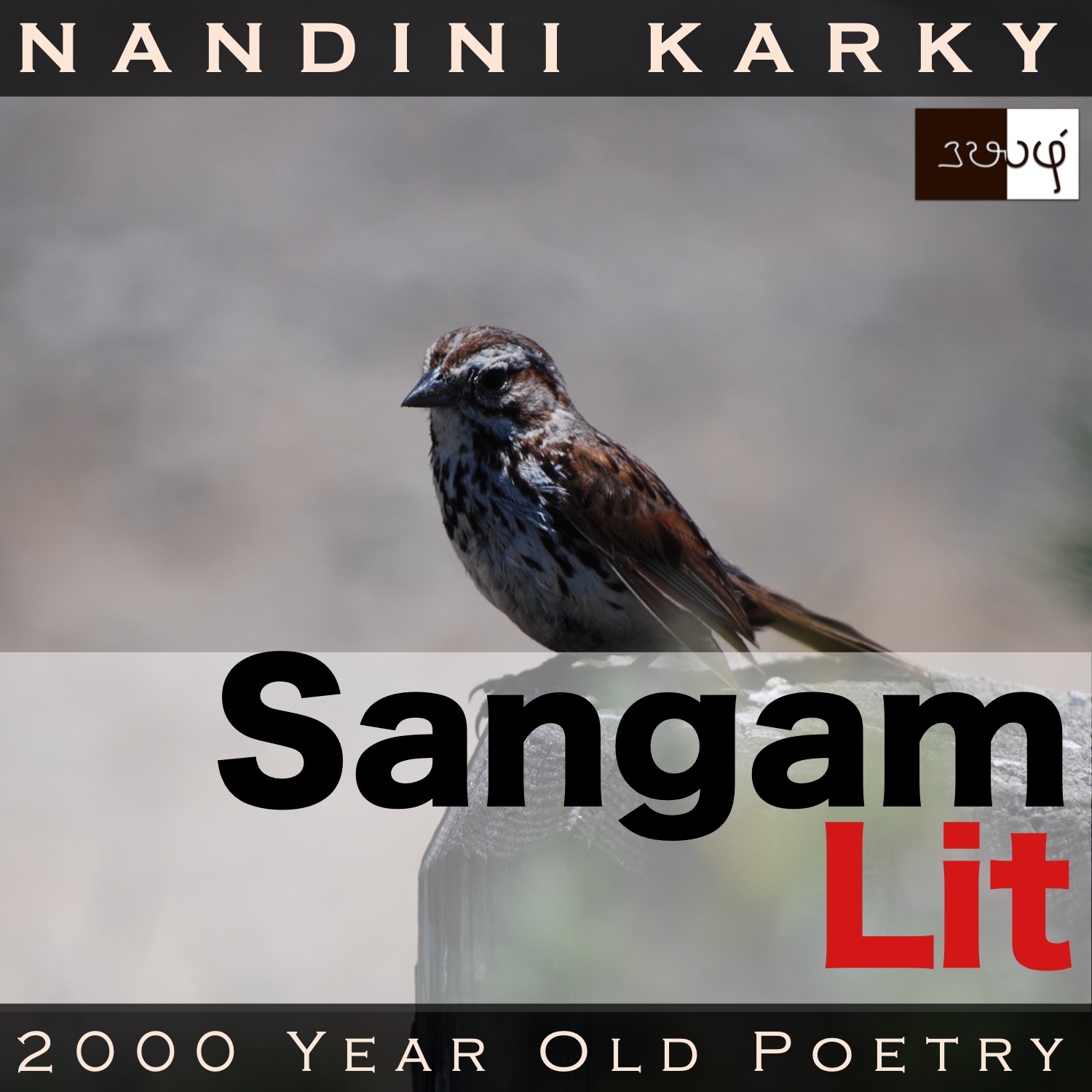Podcast: Play in new window | Download
Subscribe: Apple Podcasts | Spotify | Amazon Music | Android | iHeartRadio | TuneIn | RSS | More

In this episode, we observe a day in the life of a house sparrow, as depicted in Sangam Literary work, Kurunthogai 46, penned by Maamalaadanaar. Set in the agricultural regions of ‘Marutham’, the verse speaks in the voice of the lady to her confidante, allaying her friend’s worry that she would not be able to bear with the man’s parting.
ஆம்பற் பூவின் சாம்பல் அன்ன
கூம்பிய சிறகர் மனை உறை குரீஇ
முன்றில் உணங்கல் மாந்தி, மன்றத்து
எருவின் நுண் தாது குடைவன ஆடி,
இல் இறைப் பள்ளித் தம் பிள்ளையொடு வதியும்
புன்கண் மாலையும், புலம்பும்,
இன்றுகொல்-தோழி!-அவர் சென்ற நாட்டே?
A house sparrow hops before our eyes in this one! The verse opens with a subtle rhythm in ‘ஆம்பற் பூவின் சாம்பல்’ meaning ‘the wilted flower of the waterlily’. ‘சாம்பல்’ in contemporary Tamil refers to the ashes that arise out of burning something and has a deep spiritual significance in Indian culture, implying that’s the end of human life. In this situation, it does not refer to ‘ashes’ per se, but comes close, in talking about a dying flower. Next, the expression ‘மனை உறை குரீஇ’ refers to ‘birds that dwell in homes’, no doubt, pointing to the ‘house sparrow’! The phrase ‘முன்றில் உணங்கல்’ conveys to us the custom of laying out ‘grains to dry in the front yard of homes’. Similarly, ‘மன்றத்து எருவின் நுண் தாது’ talks about ‘the fine dust of cow dung in the town centre’. While this may sound difficult to contemplate for western audiences, this was an integral part of constructing buildings in Tamil land in ancient times. More on that, soon! ‘தம் பிள்ளையொடு வதியும்’ talks about ‘staying with the young ones’ and paints a scene of domestic bliss. ‘Suffering of evenings’ that we have encountered in many verses can be glimpsed in ‘புன்கண் மாலை’. Ending with the words ‘அவர் சென்ற நாட்டே’ meaning ‘the country that he departed to’, the verse dwells on the theme of separation and invites us to know more.
What do house sparrows have to do with the suffering of evenings? The context reveals that the man and lady had been leading a happy, married life when the man had to part with the lady to go in search of wealth. As expected, the lady languished after his departure. This made the confidante worried about how the lady would handle his separation. Perceiving the worry in the confidante, the lady says, “Akin to the withered flower of the pink lily, appears the bunched-up feathers of a house sparrow, which eats the drying grains in the front yard, pecks and plays amidst the fine dust of the cow dung floors in the town centre, and then, rests in the eaves of homes with their young ones in these suffering-filled, lonely evenings. Aren’t there such evenings, my friend, in that land that he has departed to?” With these words, the lady expresses confidence in the man’s speedy return and thereby, helps her friend overcome her worry.
A sparrow’s food, play and rest conveying hope? How does the lady manage to express her consolation convincingly? The lady starts with a stunningly apt simile, by mentioning a pink lily’s wilted flower and connects it to the cluster of feathers on a sparrow’s back. Seeing the brown-black specks on a sparrow, one can so relate it to the drooping flowers of a dried-up water lily. From the dried-up waterlily, the lady turns our attention to the drying grains on the house front yard. And, the tiny sparrow is seen picking up these grains as its food. After food, it’s time to play and we see this sparrow heading to the town centre, where it rolls in the cow dung dust therein. This reference may make uninitiated audiences wonder about the hygiene of these places. To explain to them, the cow dung is not lying there uncleaned but is actually a traditional construction material, used to plaster walls and floors. It is said to be great binder and thermal insulator, and it’s also supposed to prevent cracking in the floors and walls. The list of benefits do not stop with this and go on to include disinfecting and fungicidal properties of the material, and finally, also the surprising emotional benefits that arise from the bacteria in this base for building. With this long list of its wonders, it is no wonder that the ancients used it in the construction of their public places.
Returning to the verse, the house sparrow is, in fact, helping everyone by pecking and playing in this dust and spreading good health all around. After its good work for the day, the house sparrow then leaves to rest with its young ones in its nests amidst the eaves of those homes. The lady has described this entire scene only to say that this is happening in the lonely evenings that seem to fill her with much misery. Saying this, she asks her friend whether such evenings wouldn’t be there wherever the man has parted to. And, with that, the lady expresses the hope the man would indeed return to her fold, pushed by the same forces that attack her in those lonely evenings. In bringing that sparrow’s play, the lady employs an exquisite way to say that the beloved too would feel whatever she feels!




Share your thoughts...